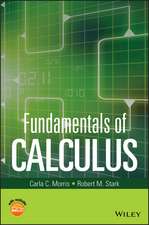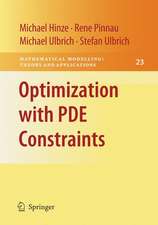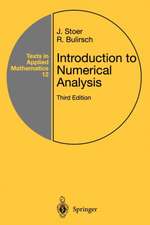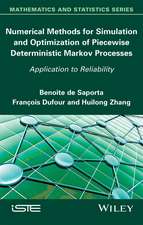Problems and Theorems in Analysis II: Theory of Functions. Zeros. Polynomials. Determinants. Number Theory. Geometry: Classics in Mathematics
Autor George Polya Traducere de C.E. Billigheimer Autor Gabor Szegöen Limba Engleză Paperback – 11 dec 1997
Din seria Classics in Mathematics
-
 Preț: 404.20 lei
Preț: 404.20 lei -
 Preț: 428.09 lei
Preț: 428.09 lei -
 Preț: 400.48 lei
Preț: 400.48 lei -
 Preț: 404.37 lei
Preț: 404.37 lei -
 Preț: 402.28 lei
Preț: 402.28 lei -
 Preț: 422.11 lei
Preț: 422.11 lei -
 Preț: 438.87 lei
Preț: 438.87 lei -
 Preț: 431.56 lei
Preț: 431.56 lei -
 Preț: 425.80 lei
Preț: 425.80 lei -
 Preț: 429.61 lei
Preț: 429.61 lei -
 Preț: 421.72 lei
Preț: 421.72 lei -
 Preț: 425.80 lei
Preț: 425.80 lei -
 Preț: 422.90 lei
Preț: 422.90 lei -
 Preț: 427.49 lei
Preț: 427.49 lei -
 Preț: 421.17 lei
Preț: 421.17 lei -
 Preț: 415.39 lei
Preț: 415.39 lei -
 Preț: 485.07 lei
Preț: 485.07 lei -
 Preț: 437.72 lei
Preț: 437.72 lei -
 Preț: 444.47 lei
Preț: 444.47 lei -
 Preț: 440.39 lei
Preț: 440.39 lei -
 Preț: 447.73 lei
Preț: 447.73 lei -
 Preț: 438.10 lei
Preț: 438.10 lei -
 Preț: 509.50 lei
Preț: 509.50 lei -
 Preț: 418.83 lei
Preț: 418.83 lei -
 Preț: 436.74 lei
Preț: 436.74 lei -
 Preț: 446.37 lei
Preț: 446.37 lei -
 Preț: 430.59 lei
Preț: 430.59 lei -
 Preț: 421.93 lei
Preț: 421.93 lei -
 Preț: 429.06 lei
Preț: 429.06 lei -
 Preț: 431.56 lei
Preț: 431.56 lei -
 Preț: 457.36 lei
Preț: 457.36 lei -
 Preț: 504.66 lei
Preț: 504.66 lei -
 Preț: 433.31 lei
Preț: 433.31 lei -
 Preț: 418.07 lei
Preț: 418.07 lei -
 Preț: 428.07 lei
Preț: 428.07 lei -
 Preț: 427.33 lei
Preț: 427.33 lei -
 Preț: 437.50 lei
Preț: 437.50 lei -
 Preț: 425.80 lei
Preț: 425.80 lei -
 Preț: 438.26 lei
Preț: 438.26 lei -
 Preț: 408.62 lei
Preț: 408.62 lei -
 Preț: 432.51 lei
Preț: 432.51 lei -
 Preț: 429.61 lei
Preț: 429.61 lei -
 Preț: 435.20 lei
Preț: 435.20 lei -
 Preț: 428.68 lei
Preț: 428.68 lei -
 Preț: 437.12 lei
Preț: 437.12 lei -
 Preț: 438.69 lei
Preț: 438.69 lei
Preț: 429.99 lei
Nou
Puncte Express: 645
Preț estimativ în valută:
82.27€ • 85.91$ • 67.94£
82.27€ • 85.91$ • 67.94£
Carte tipărită la comandă
Livrare economică 15-29 aprilie
Preluare comenzi: 021 569.72.76
Specificații
ISBN-13: 9783540636861
ISBN-10: 3540636862
Pagini: 412
Ilustrații: XII, 392 p.
Dimensiuni: 155 x 235 x 22 mm
Greutate: 0.62 kg
Ediția:1998
Editura: Springer Berlin, Heidelberg
Colecția Springer
Seria Classics in Mathematics
Locul publicării:Berlin, Heidelberg, Germany
ISBN-10: 3540636862
Pagini: 412
Ilustrații: XII, 392 p.
Dimensiuni: 155 x 235 x 22 mm
Greutate: 0.62 kg
Ediția:1998
Editura: Springer Berlin, Heidelberg
Colecția Springer
Seria Classics in Mathematics
Locul publicării:Berlin, Heidelberg, Germany
Public țintă
ResearchCuprins
Four. Functions of One Complex Variable. Special Part.- 1. Maximum Term and Central Index, Maximum Modulus and Number of Zeros.- 2. Schlicht Mappings.- 3. Miscellaneous Problems.- Five. The Location of Zeros.- 1. Rolle’s Theorem and Descartes’ Rule of Signs.- 2. The Geometry of the Complex Plane and the Zeros of Polynomials.- 3. Miscellaneous Problems.- Six. Polynomials and Trigonometric Polynomials.- § 1 (1–7) Tchebychev Polynomials.- § 2 (8–15) General Problems on Trigonometric Polynomials.- § 3 (16–28) Some Special Trigonometric Polynomials.- § 4 (29–38) Some Problems on Fourier Series.- § 5 (39–43) Real Non-negative Trigonometric Polynomials.- § 6 (44–49) Real Non-negative Polynomials.- § 7 (50–61) Maximum-Minimum Problems on Trigonometric Polynomials.- § 8 (62–66) Maximum-Minimum Problems on Polynomials.- § 9 (67–76) The Lagrange Interpolation Formula.- § 10 (77–83) The Theorems of S. Bernstein and A. Markov.- § 11 (84–102) Legendre Polynomials and Related Topics.- § 12 (103–113) Further Maximum-Minimum Problems on Polynomials.- Seven. Determinants and Quadratic Forms.- § 1 (1–16) Evaluation of Determinants. Solution of Linear Equations.- § 2 (17–34) Power Series Expansion of Rational Functions.- § 3 (35–43.2) Generation of Positive Quadratic Forms.- § 4 (44–54.4) Miscellaneous Problems.- § 5 (55–72) Determinants of Systems of Functions.- Eight. Number Theory.- 1. Arithmetical Functions.- 2. Polynomials with Integral Coefficients and Integral-Valued Functions.- 3. Arithmetical Aspects of Power Series.- 4. Some Problems on Algebraic Integers.- 5. Miscellaneous Problems.- Nine. Geometric Problems.- § 1 (1–25) Some Geometric Problems.- Errata.- § 1 Additional Problems to Part One.- New Problems in EnglishEdition.- Author Index.- Topics.
Recenzii
From the reviews: "... In the past, more of the leading mathematicians proposed and solved problems than today, and there were problem departments in many journals. Pólya and Szego must have combed all of the large problem literature from about 1850 to 1925 for their material, and their collection of the best in analysis is a heritage of lasting value. The work is unashamedly dated. With few exceptions, all of its material comes from before 1925. We can judge its vintage by a brief look at the author indices (combined). Let's start on the C's: Cantor, Carathéodory, Carleman, Carlson, Catalan, Cauchy, Cayley, Cesàro,... Or the L's: Lacour, Lagrange, Laguerre, Laisant, Lambert, Landau, Laplace, Lasker, Laurent, Lebesgue, Legendre,... Omission is also information: Carlitz, Erdös, Moser, etc."
-Bull.Americ.Math.Soc.
-Bull.Americ.Math.Soc.
Notă biografică
Biography of George Pólya
Born in Budapest, December 13, 1887, George Pólya initially studied law, then languages and literature in Budapest. He came to mathematics in order to understand philosophy, but the subject of his doctorate in 1912 was in probability theory and he promptly abandoned philosophy.
After a year in Göttingen and a short stay in Paris, he received an appointment at the ETH in Zürich. His research was multi-faceted, ranging from series, probability, number theory and combinatorics to astronomy and voting systems. Some of his deepest work was on entire functions. He also worked in conformal mappings, potential theory, boundary value problems, and isoperimetric problems in mathematical physics, as well as heuristics late in his career. When Pólya left Europe in 1940, he first went to Brown University, then two years later to Stanford, where he remained until his death on September 7, 1985.
Biography of Gabor Szegö
Born in Kunhegyes, Hungary, January 20, 1895, Szegö studied in Budapest and Vienna, where he received his Ph. D. in 1918, after serving in the Austro-Hungarian army in the First World War. He became a privatdozent at the University of Berlin and in 1926 succeeded Knopp at the University of Kšnigsberg. It was during his time in Berlin that he and Pólya collaborated on their great joint work, the Problems and Theorems in Analysis. Szegö's own research concentrated on orthogonal polynomials and Toeplitz matrices. With the deteriorating situation in Germany at that time, he moved in 1934 to Washington University, St. Louis, where he remained until 1938, when he moved to Stanford. As department head at Stanford, he arranged for Pólya to join the Stanford faculty in 1942. Szegö remained at Stanford until his death on August 7, 1985.
Born in Budapest, December 13, 1887, George Pólya initially studied law, then languages and literature in Budapest. He came to mathematics in order to understand philosophy, but the subject of his doctorate in 1912 was in probability theory and he promptly abandoned philosophy.
After a year in Göttingen and a short stay in Paris, he received an appointment at the ETH in Zürich. His research was multi-faceted, ranging from series, probability, number theory and combinatorics to astronomy and voting systems. Some of his deepest work was on entire functions. He also worked in conformal mappings, potential theory, boundary value problems, and isoperimetric problems in mathematical physics, as well as heuristics late in his career. When Pólya left Europe in 1940, he first went to Brown University, then two years later to Stanford, where he remained until his death on September 7, 1985.
Biography of Gabor Szegö
Born in Kunhegyes, Hungary, January 20, 1895, Szegö studied in Budapest and Vienna, where he received his Ph. D. in 1918, after serving in the Austro-Hungarian army in the First World War. He became a privatdozent at the University of Berlin and in 1926 succeeded Knopp at the University of Kšnigsberg. It was during his time in Berlin that he and Pólya collaborated on their great joint work, the Problems and Theorems in Analysis. Szegö's own research concentrated on orthogonal polynomials and Toeplitz matrices. With the deteriorating situation in Germany at that time, he moved in 1934 to Washington University, St. Louis, where he remained until 1938, when he moved to Stanford. As department head at Stanford, he arranged for Pólya to join the Stanford faculty in 1942. Szegö remained at Stanford until his death on August 7, 1985.
Caracteristici
Very few mathematical books are worth translating 50 years after their original publication. Polyá-Szegö is one! It was published in German by Springer in 1924, its English edition was widely acclaimed when it appeared from 1972. In the past more of the leading mathematicians proposed and solved problems than today. Their collection of the best in analysis is a heritage of lasting value.



















